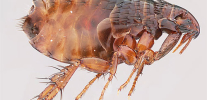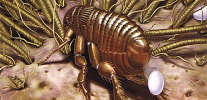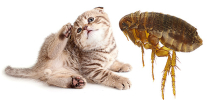
Fleas, as well as many other species of insects, in their development undergo a complete transformation. Actually, they are called so: insects with a full cycle of transformation. This means that from the eggs that the female flea lays, the larvae hatch, which are very different from the adult fleas in their appearance and way of life.
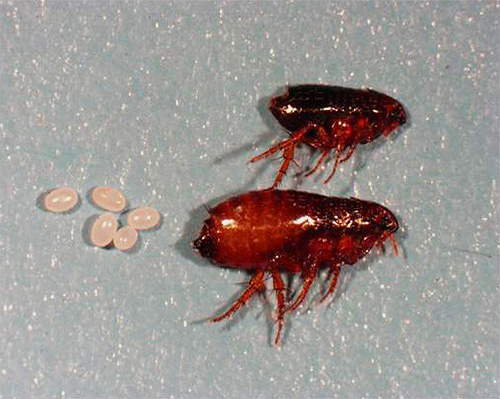
This type of development provides certain advantages for insects: flea larvae and adults do not compete with each other for food sources and habitats, and, accordingly, at each stage of development, the parasites have a better chance of survival.
However, for those trying fight fleas for example in an apartment or at home, this type of development of parasites creates certain difficulties: in some cases it is necessary to destroy the larvae using additional means and measures. But first of all, they must also be able to be found, in order to know which places to treat with insecticides.
What do the flea larvae look like?
Flea larvae look like tiny white worms in white with a translucent little body. Even after a closer look, they cannot see the paws - they simply do not exist. But the body of the larva is covered with sparse hairs, clearly visible under a magnifying glass or microscope.
On a photo enlarged several times - a flea larva:


In her body, the esophagus is clearly visible, filled with indigestible food — various organic residues.
The maximum length of flea larvae that can be found in residential areas is 4-5 mm, and the usual length is 2-3 mm. They are easily confused with the larvae of flies, which live in similar places, but at the same time the maggots are more mobile and have no so transparent body covers.


The flea larva has a rather large head and 13 segments. Evolutionarily, the first three segments served to attach the legs, but gradually the limbs atrophied as superfluous. Flea larvae have well-developed jaws of the scraping-gnawing type, allowing them to feed on rather rough fodder.
The photo below shows the flea eggs and larvae:

It is interesting
The smallest flea larvae that have just emerged from the egg have a small egg tooth on the crown - a solid growth that helps them to break through the egg shell and emerge into the light. At the first molt, the tooth disappears along with the chitinous membrane of the body.
Regardless of whether the flea is parasitic on cats, dogs or rats (cat, dog and rat fleas), insect larvae look almost the same. Therefore, detecting flea larvae in cats on the litter or place of rest, you can never be sure what kind of species they belong to. And there is no particular need for this - the way of life of all these species is similar, and they should be fought with the same methods.
In the photo - flea larvae in large numbers in a rodent cage:

Lifestyles and nutrition of future parasites
In general, flea larvae are not parasites. Their food consists of various decaying organic matter, from plant residues to the excrement of adult fleas, in which the undigested blood of the victim is preserved. The larvae themselves do not bite neither animals nor humans.
On a note
Flea larvae in cats and dogs do not live on wool. If any worm-like parasites were found in a pet, these are not flea larvae.
The development of the larvae continues, depending on the availability of food and temperature conditions, from 9 days to several months.

Under optimal conditions - a temperature of about 23 ° C and a humidity of 60% of the larvae develop approximately three weeks. During this time, they molt three times, constantly growing and feeding.At the last stage, the larva entangles itself with a thin silk cocoon and turns into a pupa.
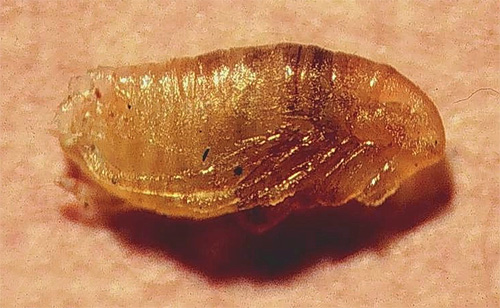
At too high temperatures, the flea larvae dry out - at low humidity it occurs already at 34-36 ° C. At high air humidity (up to 90%), young fry are experiencing this temperature quite normally.
Flea larvae can starve long enough - up to 3-4 weeks. However, they do not develop, do not grow, but do not fall into anabiosis. In the larvae the so-called negative phototaxis is developed - wherever they turn out, they try to get into the least lit place. Although the eyes of flea larvae are practically undeveloped, they feel the presence of light well and try to escape from the lighted area.
Where to look for flea larvae in an apartment or house?
Flea larvae are usually kept where they have direct access to food and can be in comfortable climatic conditions — in garbage, secluded warm places, in animal cages — in the toilet and under the beds. In nature - in the nests and burrows of mammals and birds.
In the apartments and houses of flea larvae, one should look first of all in places of rest and keeping cats, dogs and other domestic animals, in heaps of garbage in storerooms and closets, among stocks of old grocery products.

On homestead plots in chicken coops and animal housing areas, flea larvae live directly in the litter and dried litter. It is under a layer of rubbish and litter in the same henhouse that flea larvae sometimes swarm literally in the thousands.
However, you can find flea larvae in completely unexpected places - in vases of flowers, under a garbage bin, in a box in which vegetables are stored. It is important to understand that by themselves they do not start here, and they should be sought only when adult fleas were found in the apartment.
The photo below shows a flea larva under a microscope - you can easily relate its size to the thickness of a cat's hair:

Means and methods for the destruction of flea larvae
To destroy flea larvae in the room should be the same means that are used against adult fleas:
- these can be concentrates for dilution such as Executioner, Cucaracha or Tetrix, Raptor or Combat aerosols;
- as well as microencapsulated products such as Dana or Get (the latter has almost no odor);
- and even folk remedies - turpentine, kerosene, vinegar.

Traditional substances such as Dichlorvos or Karbofos are effective against flea larvae; however, in their safety and ease of use they are much inferior to modern preparations.
Dusts, which are practically useless against adults, are also effective against flea larvae. However, it is somewhat more difficult to use powdered insecticides, since they need to be scattered in the places of permanent dislocation of the larvae, which is sometimes problematic, and sometimes - when the larvae are located behind the plinths or under the floor - it is completely impossible.


In this case, it is very important that the dust itself should certainly be near the larvae, since it acts only when the pests eat it along with other food. Therefore, it turns out to be more difficult to fight with the larvae than with adult fleas - even with aerosols, when dealing with them, it is necessary to handle places where it is very difficult to get close to and where adult fleas themselves do not occur.
It makes no sense to display the young juveniles of the parasites with natural preparations that can only scare them away. For example, if the same wormwood or tansy can scare adult parasites out of the room, the larvae even in the atmosphere of such herbs will have nowhere to go, and they will simply get used to such scaring agents.

It is interesting
With the constant removal of fleas by folk repellents, they quickly develop resistance to them.So, for example, cases of the development of resistance in fleas to wormwood, eucalyptus, and thyme — herbs traditionally used as a means for removing parasites from a room — have been documented. Such stability almost always develops at the larval stage.
Flea larvae do not penetrate into the room on their own, on cats or dogs. They can appear here only from eggs laid by adult insects. Therefore, the only way to protect an apartment from flea larvae is to prevent adult biting parasites from entering the room.
Example of a carpet literally infested with flea larvae
Video about breeding fleas: from egg to larva and adult

